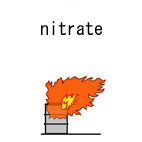| Case Name |
Fire occurred due to dispersion of molten nitrate caused by high-pressure steam entering into a molten nitrate vessel of a phthalic anhydride reactor after opening a steam generation tube |
| Pictograph |

|
| Date |
November 15, 1990 |
| Place |
Kawasaki, Kanagawa, Japan |
| Location |
Chemical factory |
| Overview |
Molten nitrate used as a cooling medium of a phthalic anhydride reactor spouted out. Part of the tube where steam was generated for cooling molten nitrate was broken by erosion, and steam entered the molten nitrate vessel, which caused spouting. The design of the damaged part where the wall thickness of the tubes readily decreases was not adequate. |
| Incident |
Molten nitrate used as a source of heat for the phthalic anhydride reactor spouted out. Refer to Fig2. |
| Processing |
Manufacture |
| Individual Process |
Reaction |
| Chemical Reaction |
Oxidation |
| Substance |
Nitrate (Mixture of Sodium nitrate, Potassium Nitrate and Sodium Nitrite) |
| Type of Accident |
Leakage, fire |
| Sequence |
The alarm sounded to inform of abnormal temperature in the reactor that manufactured phthalic anhydride by oxidizing orthoxylene. The molten nitrate used as a cooling medium spouted from the upper part of the reactor, and some flames were also observed. The nitrate cooler of the reactor had been in use since 1979. As a pinhole was detected in May, 1989, it was scheduled to be replaced with a newly designed one in December, 1990, one month after the accident. |
| Cause |
A part of the tube where steam is generated for cooling molten nitrate was broken by erosion, and steam entered the molten nitrate vessel, which caused spouting. Steam pressure was 2.8 MPaG, and nearly atmospheric pressure in the molten nitrate vessel. |
| Response |
Emergency shutdown |
| Countermeasures |
1. Materials used for the salt cooler were changed.
2. Inspection points and cycles of the salt cooler were defined. |
| Knowledge Comment |
There is an optimum range of flow velocities for the tubes of a heat exchanger. Changing velocity by doing irregular acts can have serious effects. Besides, a mixed flow of vapor and liquid requires special attention to erosion caused by mist. Thorough study is necessary at the design stage if any unusual actions are planned. |
| Background |
The reactor was a compound heat exchanger with a complex structure. The shell side of the exchanger had a double-cylinder structure, and the tubes for the oxidation reaction were installed in the external cylinder while the tubes for steam generation and heat removal were installed in the inner cylinder. The molten nitrate circulated in the external cylinder where oxidation heat was removed, as well as in the inner cylinder where the generation of steam was used to cool nitrate in the shell. The inner cylinder of the reactor was called a salt cooler. During the accident, a blow-off pipe for preventing impurities being accumulated in the steam generation tubes was taken out, which caused a greater flow velocity in this particular area, and accelerated steam erosion of the tube. It is also considered that there was a mixed flow of hot water and steam. High-pressure steam leaked out at the molten salt side. Inadequate design of heat exchanger caused the accident. |
| Reason for Adding to DB |
Example of typical accident caused due to inadequate equipment design |
| Scenario |
| Primary Scenario
|
Insufficient Analysis or Research, Insufficient Prior Research, Erosion of Heat Exchanger Tube, Poor Value Perception, Poor Safety Awareness, Inadequate Risk Recognition, Planning and Design, Poor Planning, Poor Design, Usage, Maintenance/Repair, Insufficient Inspection, Bad Event, Thermo-Fluid Event, Erosion, Secondary Damage, External Damage, Leakage
|
|
| Sources |
Kawasaki City Fire fighting station Prevention division, Peace section. Outline of fire accident at phthalic anhydride manufacturing plant in K chemical industry Co., Ltd. K factory. Material of the Kawasaki City Complex safety countermeasure committee
|
| Physical Damage |
About four tons of molten nitrate spouted. Instrument cables, etc. of the reactor were partially damaged by fire. |
| Multimedia Files |
Fig2.Equipment Explanation drawing
|
| Field |
Chemicals and Plants
|
| Author |
WAKAKURA, Masahide (Kanagawa Industrial Technology Research Institute)
TAMURA, Masamitsu (Center for Risk Management and Safety Sciences, Yokohama National University)
|